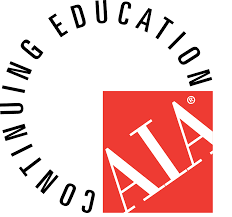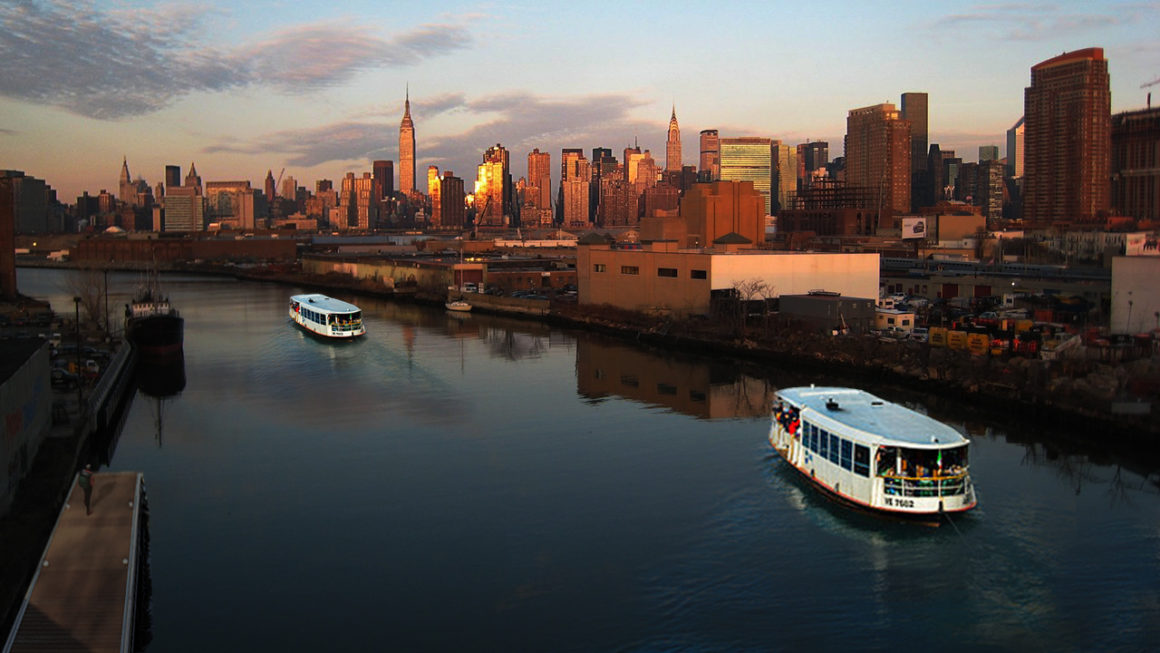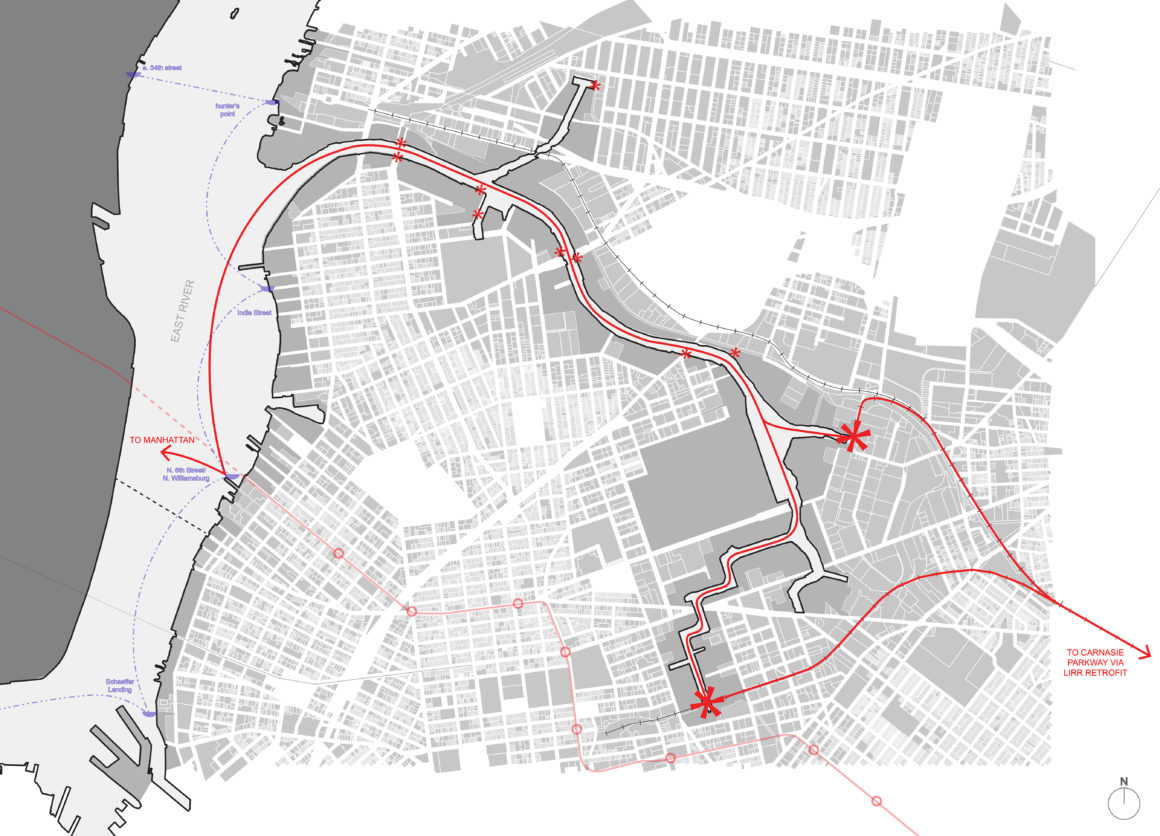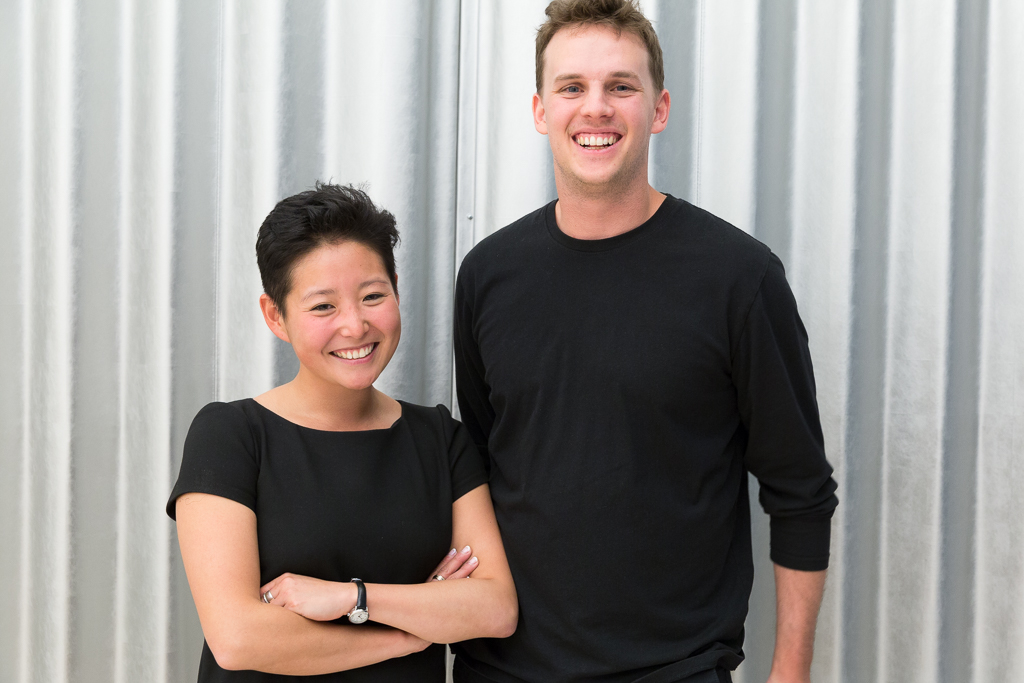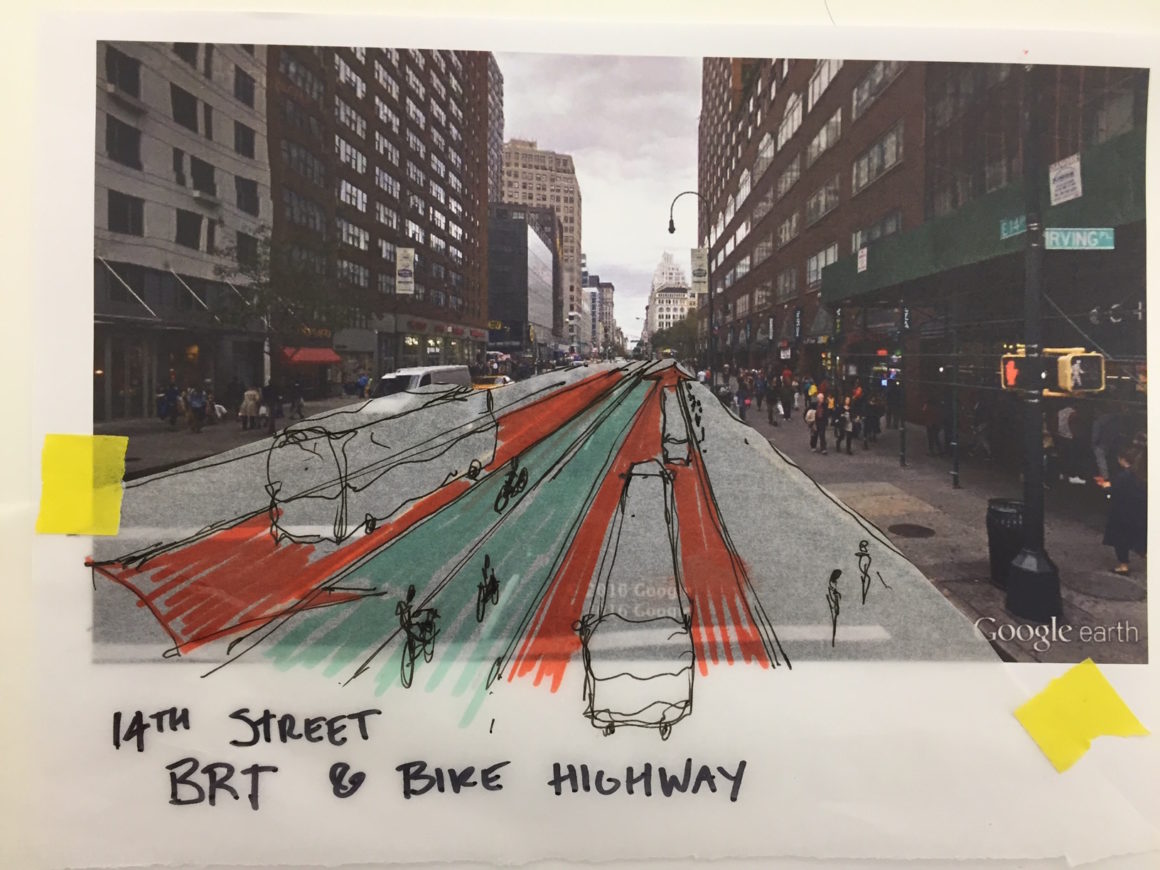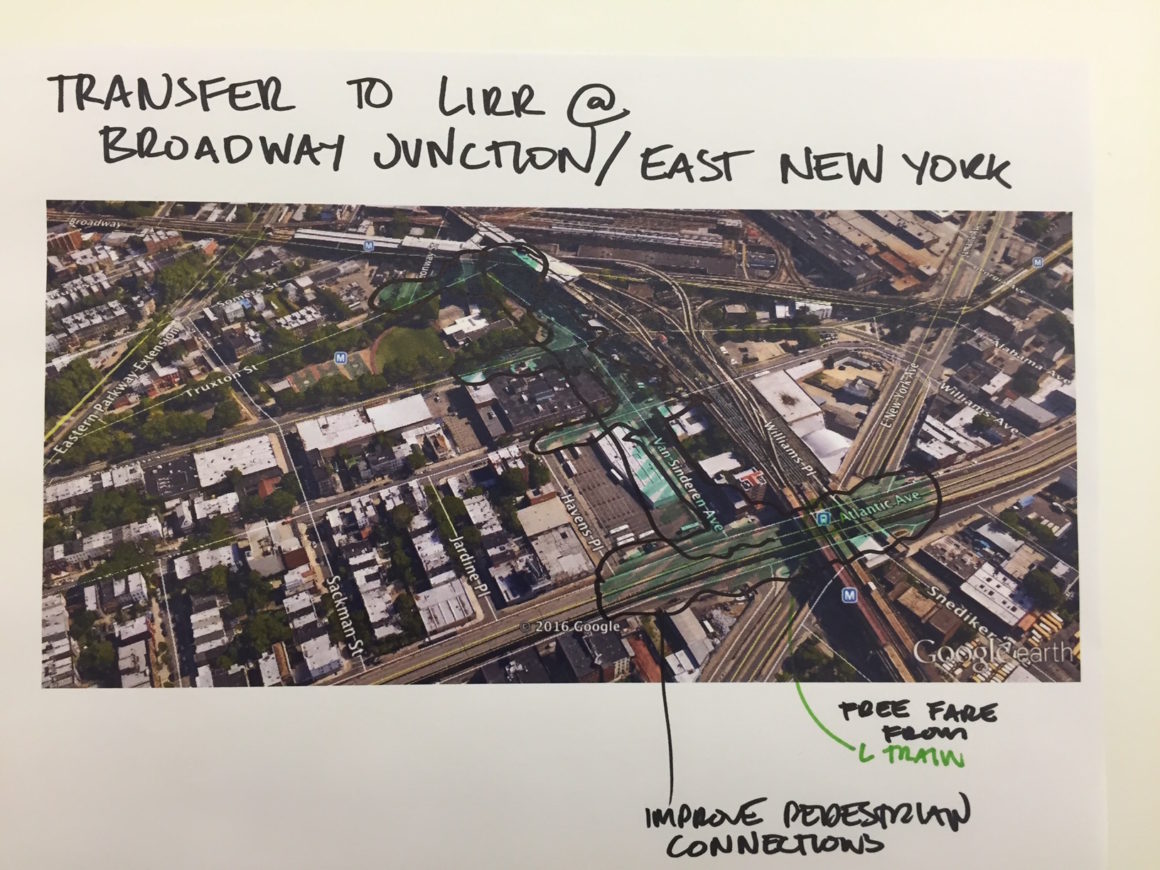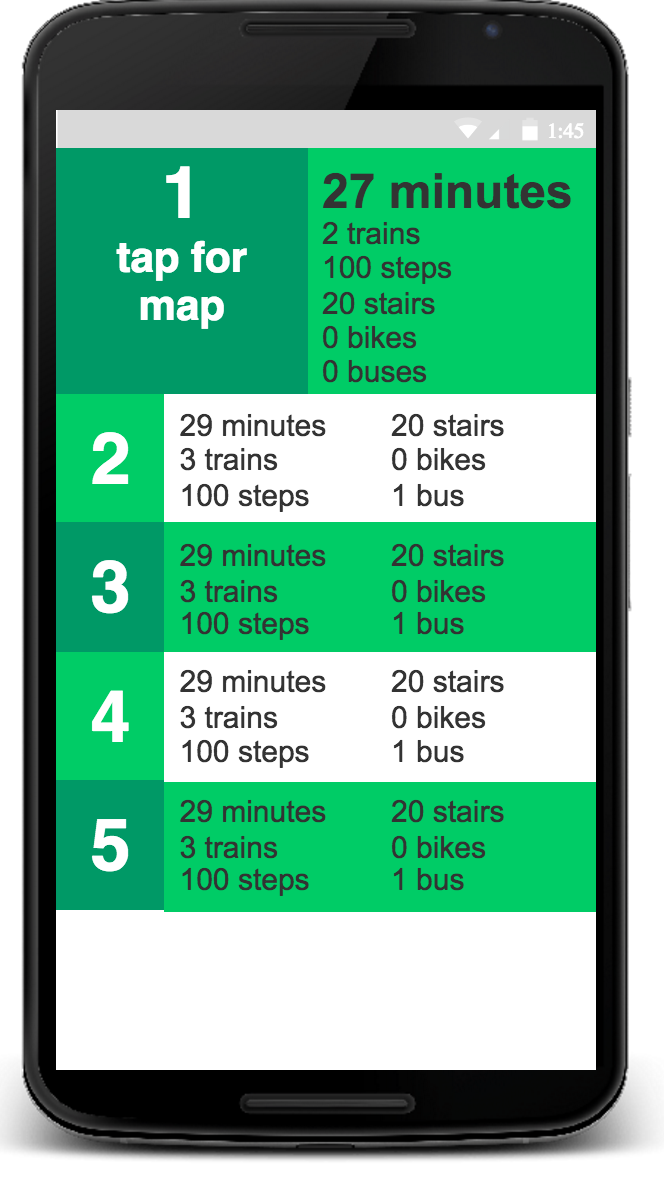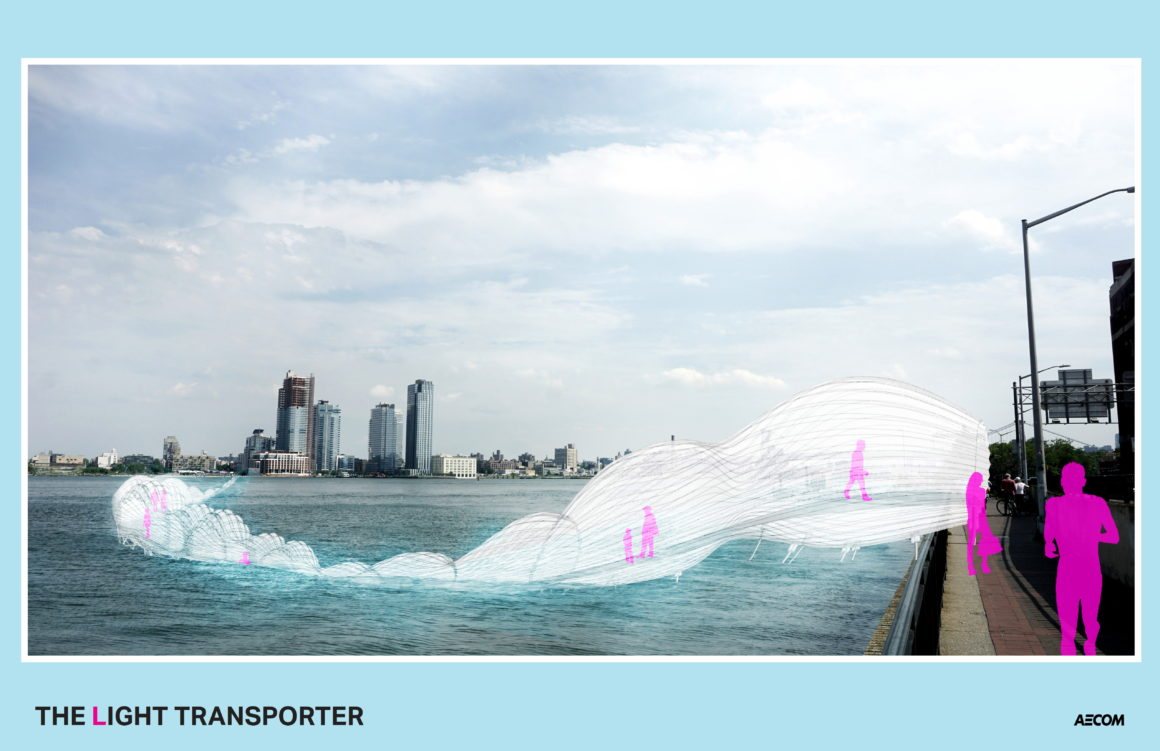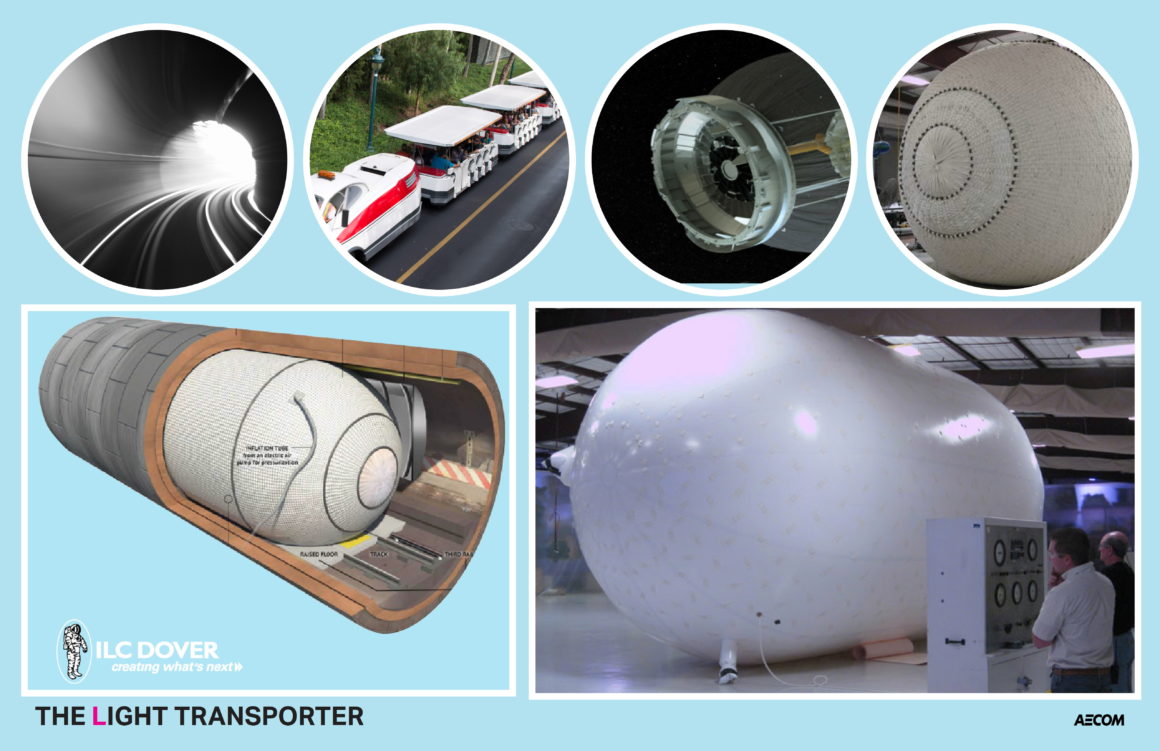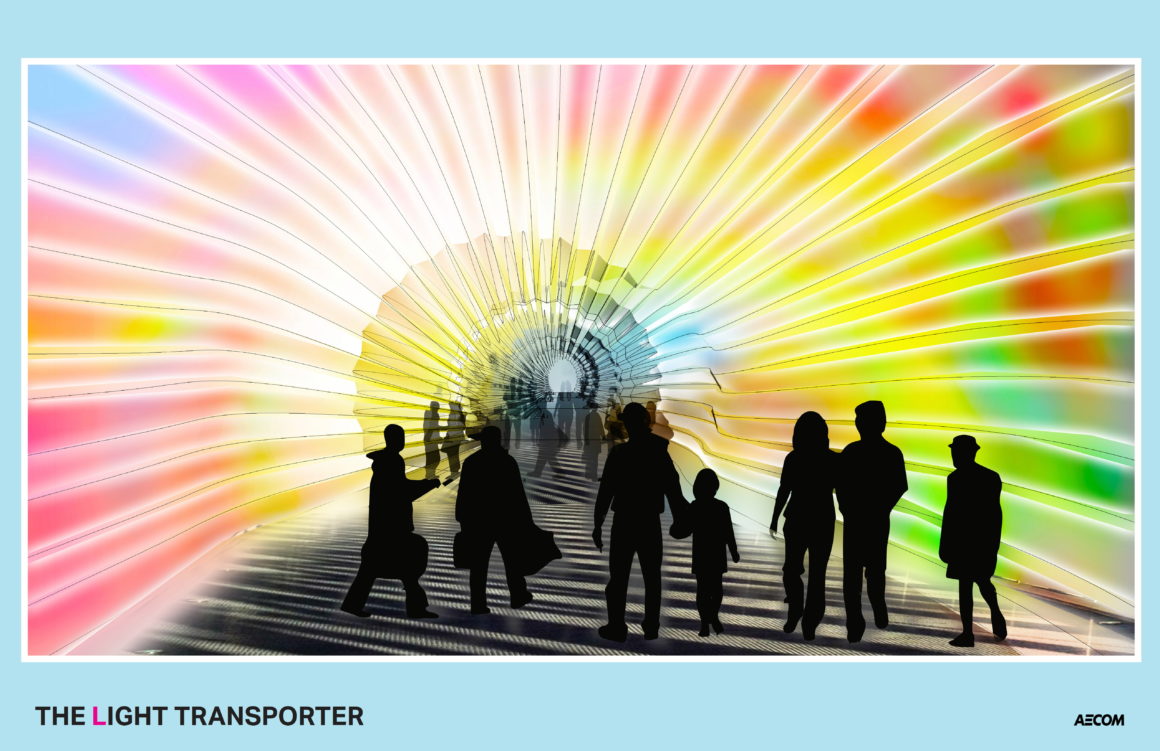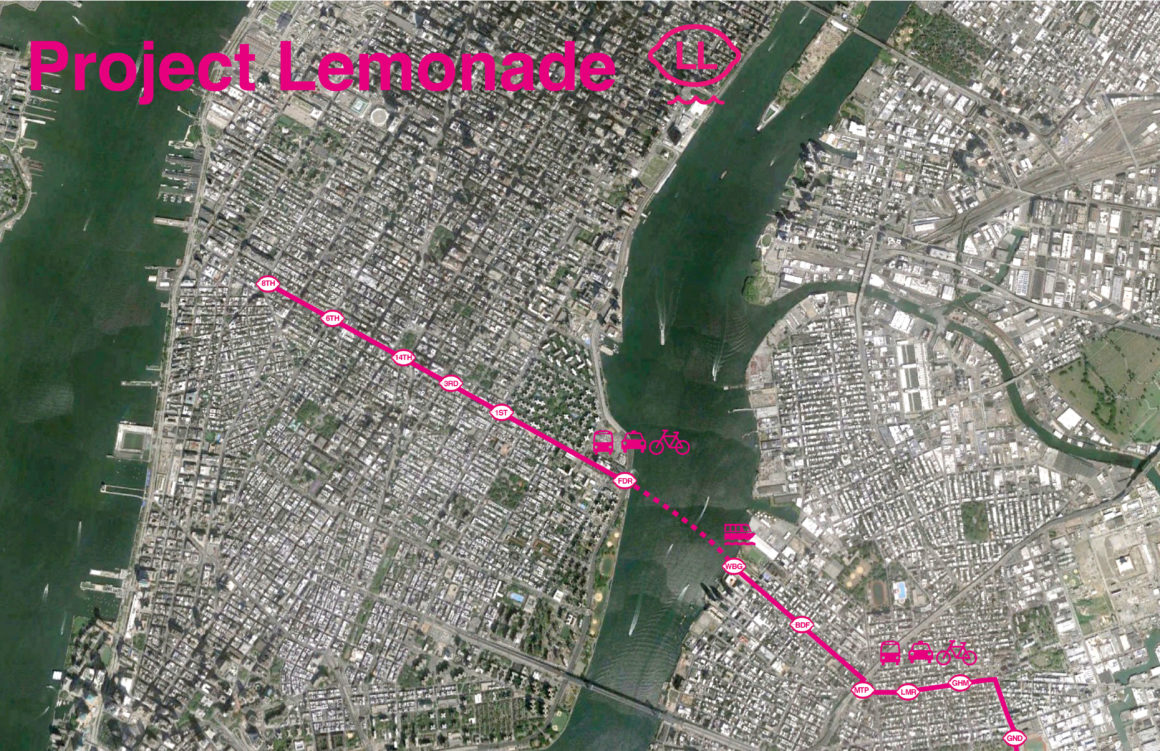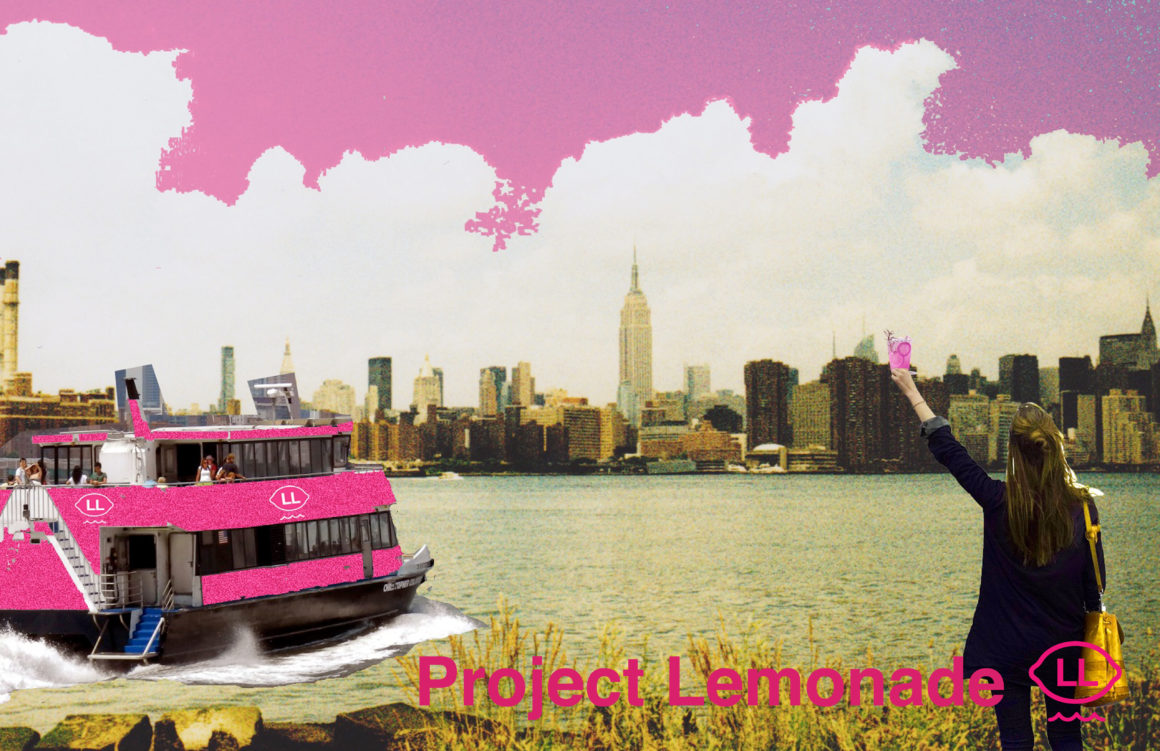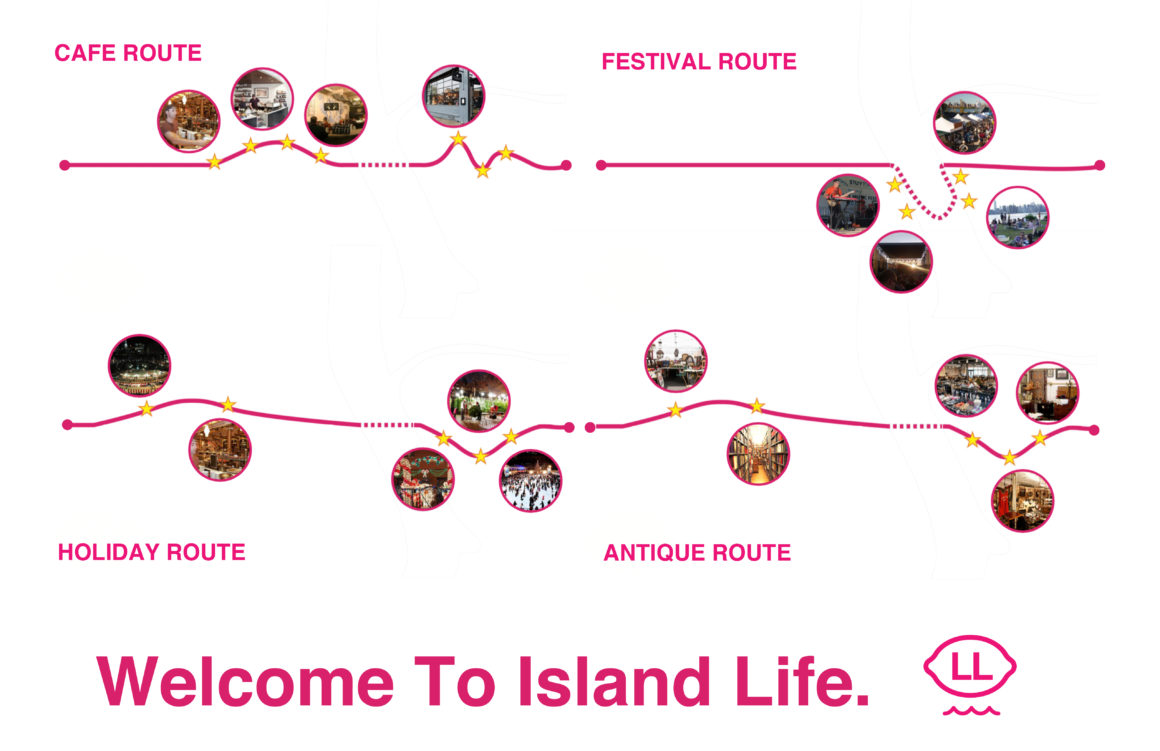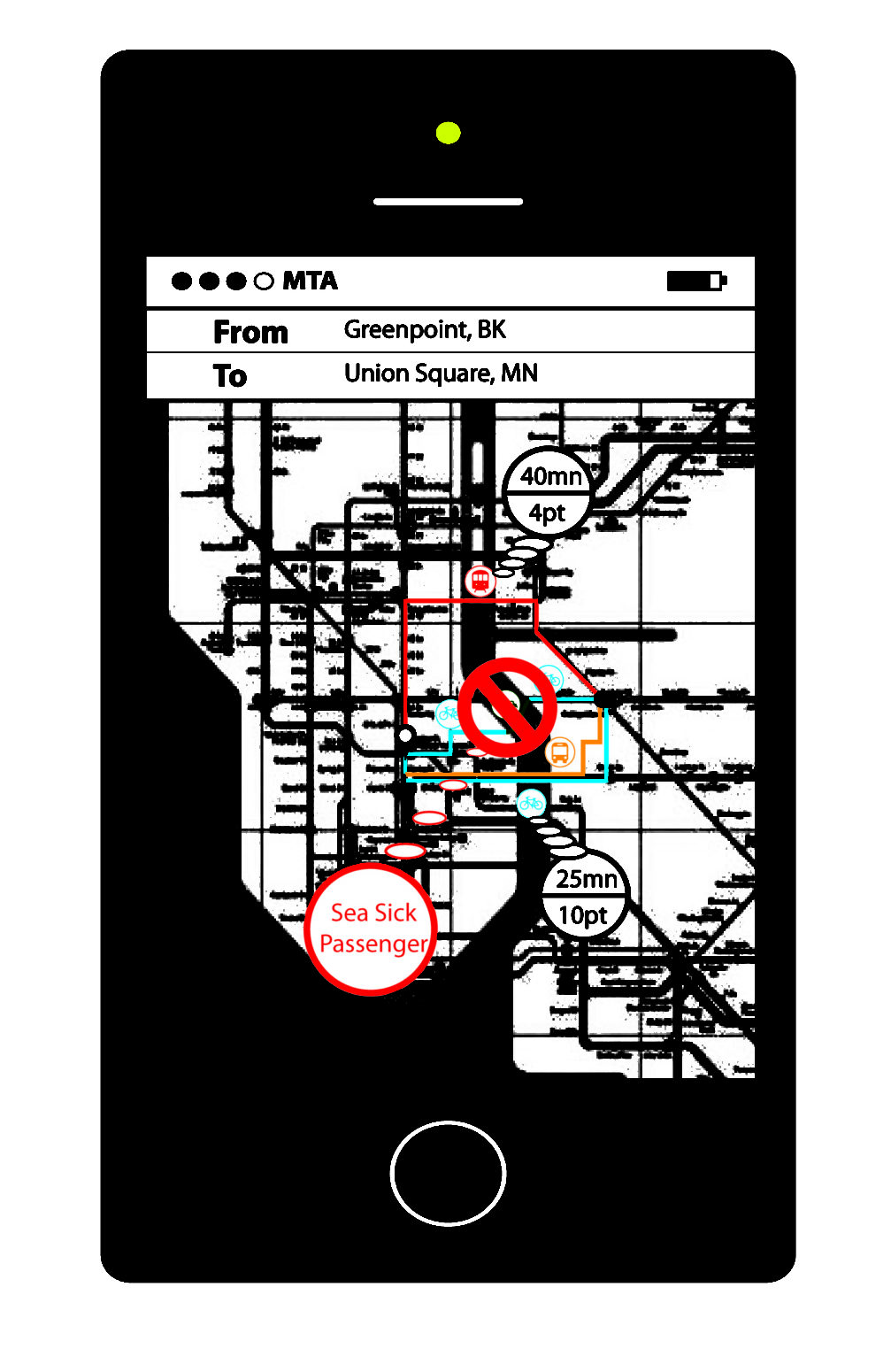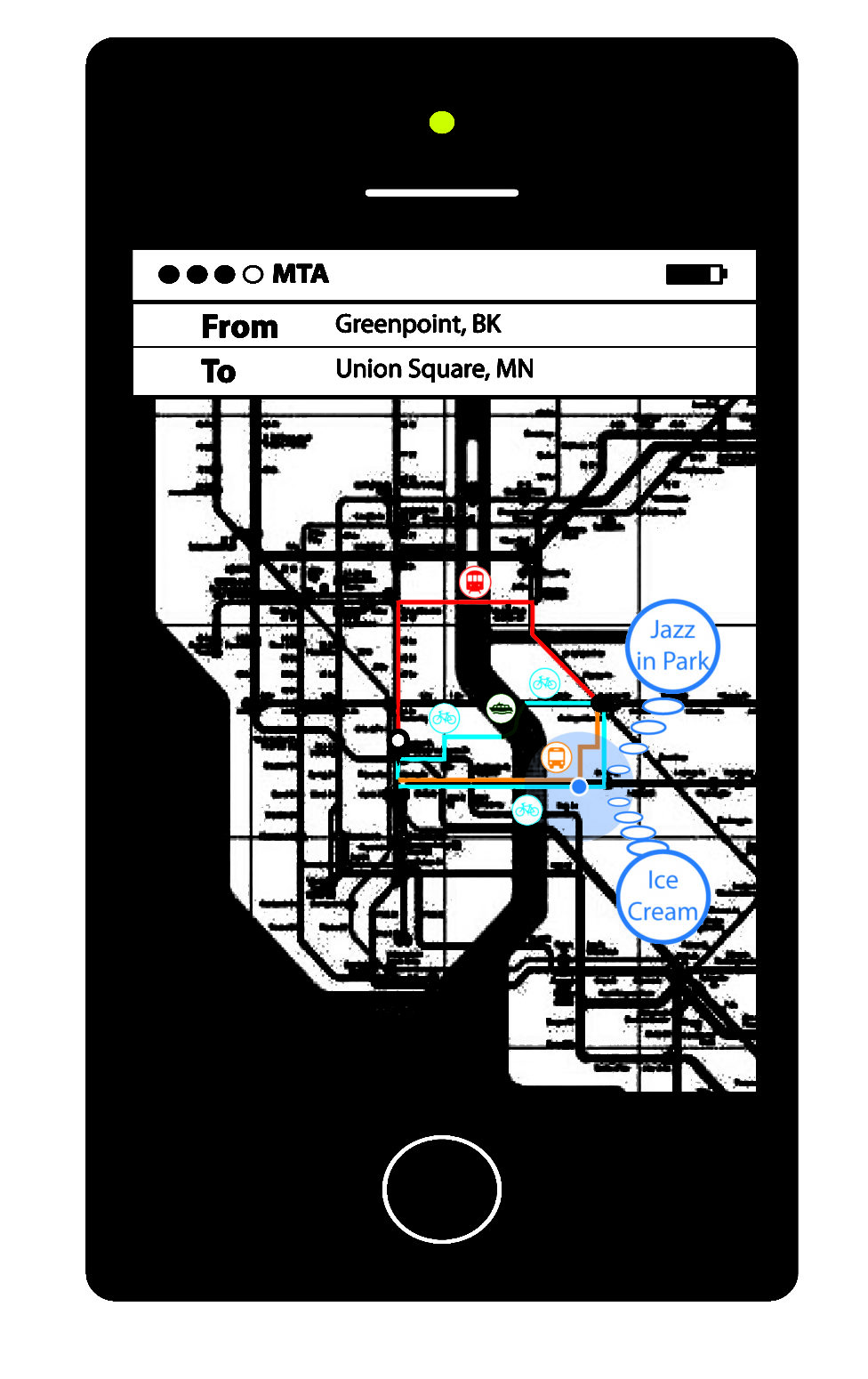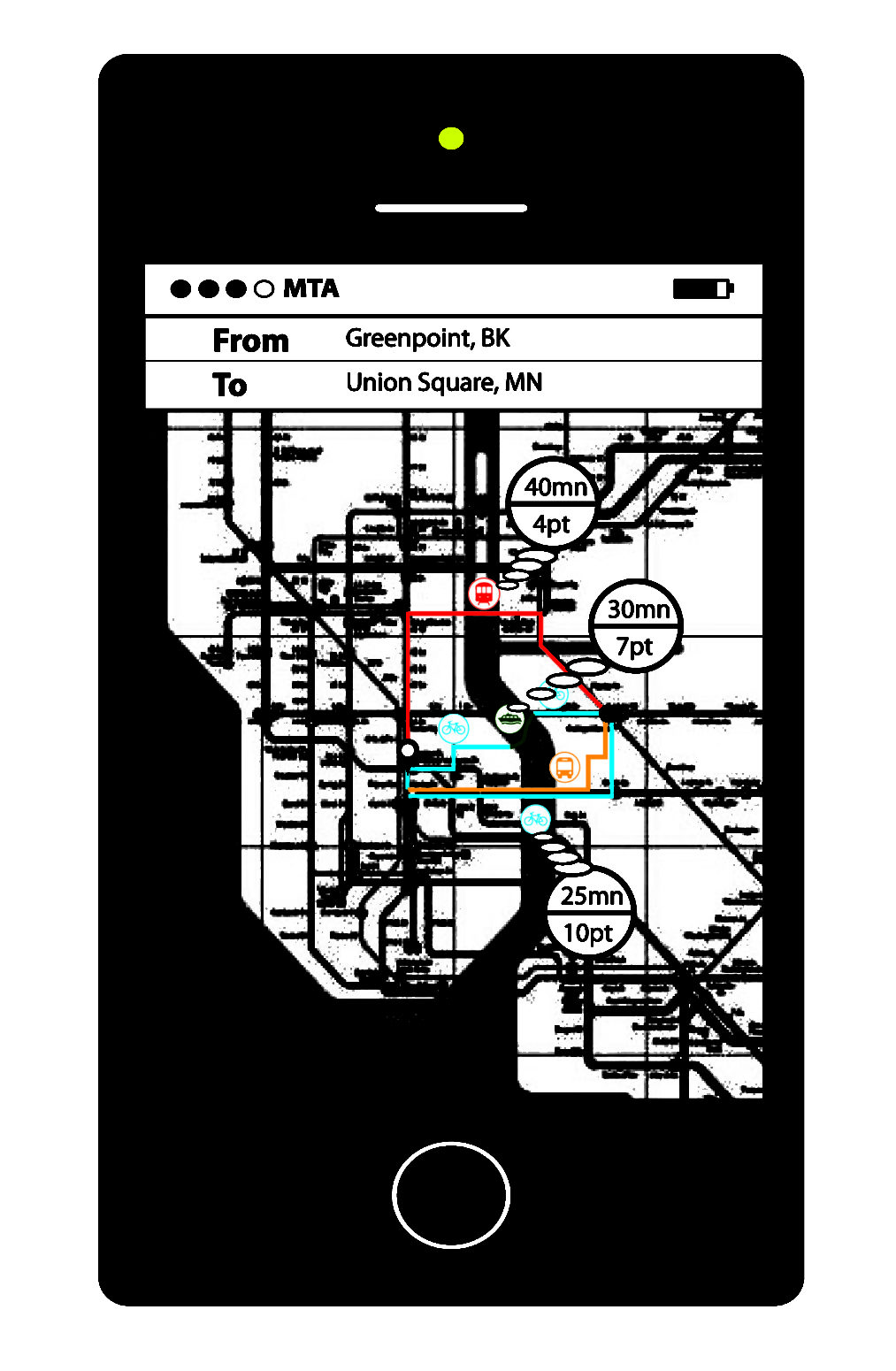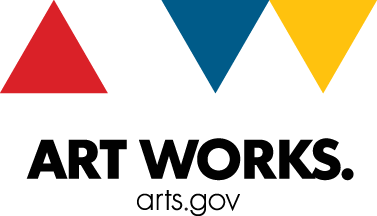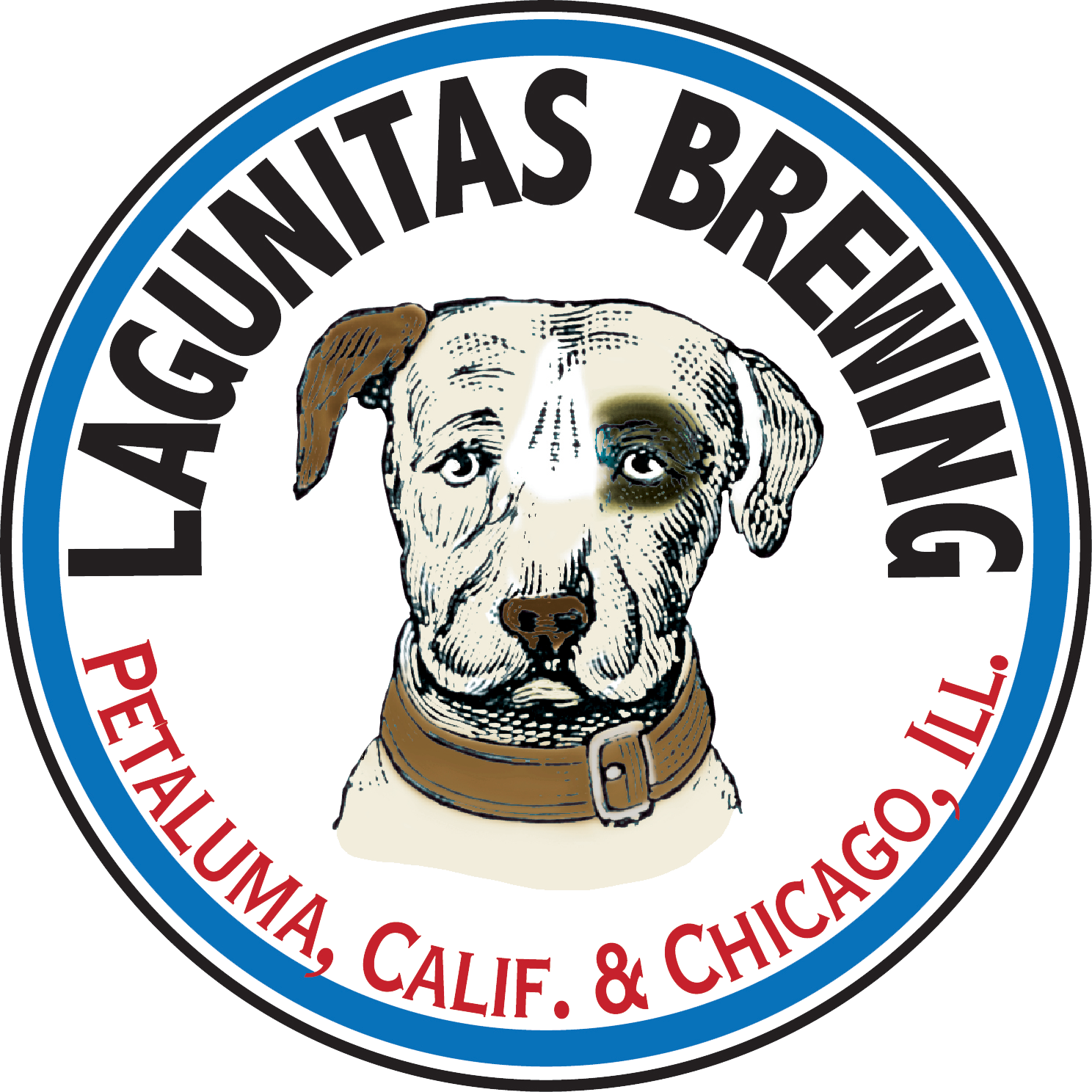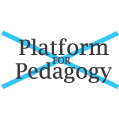As neighborhoods along the L train brace for an interruption in service of unprecedented scale, this fast-paced competition asks interdisciplinary teams to propose implementable interventions that look beyond shuttle buses and private cars.
Part of the Van Alen Spring Festival, Disruption?, the L Train Shutdown Charrette invited teams to “disrupt” the complex process of public transportation improvement. The one-day charrette offered an opportunity for fresh thinking, allowing for interdisciplinary teams to imagine systemic design solutions for hundreds of thousands of New Yorkers during an extended period of reduced subway service.
Following a workshop period among teams, community members were invited to attend the presentation of proposals and ask questions. A jury of planning experts judged the entries and announced the winner and finalists at the conclusion of the event.
Winning proposal
Transient Transit – Revitalizing Industrial Infrastructure
Team: Youngjin Yi, mechanical engineer, Buro Happold Engineering; Dillon
Pranger, architectural designer, Kohn Pedersen Fox Associates
Transient Transit proposes the development of two additional forms of transit in north Brooklyn by water and rail through the adaptation of existing but underused New York City industrial infrastructure: Newtown Creek and the LIRR freight track operating between Fresh Pond Junction and the Bushwick Branch.
Newtown Creek is the border between Queens and North Brooklyn, not far from the residential areas of many L-train commuters in Greenpoint and Williamsburg. The narrow body of water lends itself to vaporetto-style, low-capacity and high-frequency water shuttles operating between Dekalb Avenue, the North Williamsburg Ferry Pier, and Manhattan. The proposed improvements along the creek also introduce opportunities for economic development and job training programs for residents of the affected areas. The LIRR freight track between Fresh Pond Junction and the Bushwick Branch is an active ground-level freight track with existing electric infrastructure, making it viable for passenger service. The track runs parallel to the L train in East Brooklyn and extends north to the terminus of Newtown Creek, whichwould become a transfer site for riders to continue on to the proposed Newtown Creek water shuttle system.
Honorable mention
No One Thing
Thaddeus Pawlowski, Senior Urban Designer, New York City Department of City Planning; Zac Frank, Product Director, Vanity Fair; Dani Simons, Director of Communications and External Affairs, Motivate, operator of Citi Bike
A proposal for six scalable options that would be cost effective to implement.
One solution alone will not address the challenges that will face a quarter-million MTA riders when the L train shuts down in early 2019. A combination of technological, policy, and design interventions are needed to keep things moving cost effectively. A multi-pronged strategy might include:
1) Shutting down automobile traffic across 14th street in Manhattan to allow for a bikeway/busway leading from the Williamsburg Bridge, as well as Bus Rapid Transit from Brooklyn over the Williamsburg Bridge
2) Piloting a ticket system that allows riders to pay a flat fare for access to commuter rail, subway, express bus and bus in a given zone
3) Improvements to the public realm at key transit hubs to facilitate transfers and increase the economic development potential for small businesses around these hubs
4) Expansion of capacity for Citi Bike and ferries, and consideration for subsidy or free transfers to encourage people to shift to these forms of transit, reducing congestion on trains and buses
5) Overnight truck delivery regulations to reduce congestion and improve safety on local streets in Brooklyn, on East River Bridges, and along 14th Street
6) A responsive, mobile website to help all New Yorkers navigate these changes and choose the best option to keep moving. All of these interventions are relatively inexpensive and quick to implement. A strategic combination will improve quality of life and help small businesses during the shutdown and beyond.
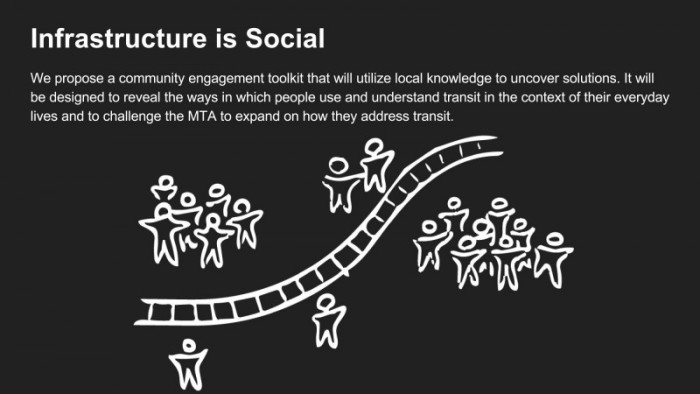
Honorable mention
I <3 the L
Nadine Rachid, Design & Urban Ecologies recent graduate, The New School; Darcy Bender; Design & Urban Ecologies recent graduate, The New School; Dimitra Kourrisova, urban theorist, and architect
The proposal offers a planning process that can be used to engage community member input and be used by the MTA, this proposal presented important engagement tools.
The tactics the MTA uses to address the challenge of the L train shutdown need to be as diverse as the people that ride the L. Our proposal is based on the belief that there is no single solution that would be equally effective for all 200,000 daily riders. Therefore, we propose a community engagement toolkit that will use local knowledge to uncover solutions. It will be designed to reveal the ways in which people use and understand transit in the context of their everyday lives.
This challenge has two sides: the physical infrastructure, which consists of alternative transit option such as other subway lines, buses, ferries, and bike lanes; and the social infrastructure, which includes the communication between the MTA, local businesses, and riders who rely on the L train. Our project will be funded by developers and businesses that profit most directly from riders who use the L.
Finalist
Light at the End of the Tunnel
Gonzalo Cruz, Landscape Architect, Lead, AECOM; Xiaofei Shen, Engineer, AECOM; Garrett Avery, Landscape Architect, AECOM; Rayana Hossain, Landscape Architecture Intern, AECOM
We propose a transporter tunnel for New Yorkers as a temporary solution to alleviate mobility between Manhattan and Brooklyn. Using technology developed by NASA, the project would create an alternative route via a covered translucent tunnel immersed within the East River with digitally -enhanced environments for commuters as they make their journey across the river. The 2,400-foot tunnel will allow pedestrians and bikers to navigate a fantastical throughway all year round. On the ground, commuters will travel in a fast cart people-mover commuter system along the shutdown path along 14th Street (Manhattan) and North 7th Street (Brooklyn) to provide a connection to THE L TRANSPORTER entrances located on the river edges.
The system could be accommodated within the existing tunnel, either underwater or as a floating and partially submerged tunnel along the river to accommodate other forms of river navigation. The project would be temporary, could be prefabricated offsite within 6 months, and easily deployable.
Finalist
Project Lemonade
Jaime Daroca, Columbia University C-Lab; Nicolas Lee, Hollwich Kushner; Daniela Leon, Harvard GSD; John Tubles, Pei Cobb Freed Architects
In 2019, New York becomes what it really is… an island. Enter Lemonade Line (LL), a multimodal transportation strategy that provides an all-access pass to seamlessly linked buses, bikes, car-shares, and ferry lines following the L line above ground.
In addition to replacing the L subway route, LL will help users to identify alternative paths that explore Brooklyn, the East River shorelines and Manhattan neighborhoods. LL is supported by large and small-scale New York partnerships. LL utilizes an all-in-one app, which facilitates and evolves this network, based on real-time data throughout the closure. Imagine island life included in your daily commute, making life a bit sweeter.
Finalist
Infraflex
Greg Reaves, Architect & Partner, Moshe Safdie Architects; Steven Haardt, Architect, Principal at Haardt Studio; Petra Kempf, Architect; Urban Designer, Urbantransits.Net; Ziyan Zeng, Planner & Programer, Urbantransits.Net
InfraFlex is a mobile app that connects existing and proposed modes of transportation with current data-collection technology. This application will provide residents affected by the shutdown with real-time travel information to make smart choices when using different modes of transportation in Manhattan and Brooklyn without adding carbon emissions to the environment.
Each resident will automatically collect game points towards the cost of their trip via the app. The more environmentally friendly their choices, the more points they (and ultimately, their neighborhood) can accumulate. Rewards could range from free admissions to museums, a year-long pass to public transportation in NYC to the implementation of new neighborhood facilities.
Competition Details
You and your team will identify an implementable solution to moving populations along the L train impacted by the shutdown in service. Teams must contain at least one professional working in architecture, urban planning, or infrastructure engineering. To generate the greatest diversity of ideas, we encourage teams to also feature a range of disciplines, which could include digital programmers, community organizers and activists, wayfinding designers, landscape designers, and economic development experts.
Submit your 150-word concept and names and affiliations of team members by midnight EDT on June 9. On June 10, a selection of five-seven finalist teams will be invited to participate in the charrette on Sunday, June 12, 12:30pm at Van Alen Institute.
12:30pm – 4:00pm: Teams will work through a set of prompts, refining a proposal to be presented in a format that will be revealed at the beginning of the workshop. Materials and lunch will be provided.
4:00pm – 5:30pm: Teams will present their proposals and answer questions before a jury and open audience.
5:30pm – 6:15pm: As the jury privately determines the best proposal, attendees are invited to enjoy a drink and discuss ideas with the competition teams.
At 6:15pm, the winning team will be announced. The team will be awarded a $1,000 cash prize and work closely with Van Alen to further refine their proposal.
This event is designated for AIA CES (3 LU | HSW)
Preliminary Questions:
- How can infrastructure interventions be designed to move large numbers of passengers when the train is shut down?
- How can technology facilitate more efficient—or less stressful—transportation during the shutdown?
- How does your proposal address an 18-month service shutdown versus a 3-year, 75% reduction in service?
- How will your proposal be funded?
- How can ideas be presented to the public and government agencies in an exciting yet serious way?
Jury
Christopher Bonanos, Senior Editor, New York magazine
Tim Braine, Founder & Executive Director, The Station Alliance
David van der Leer (jury chair), Executive Director, Van Alen Institute
Erin Maciel, Project Manager, New York City Department of Transportation
John Maier, Co-Chair, Public Transit Services Committee, Queens Community Board No. 5
Shin-pei Tsay, Deputy Executive Director, Transit Center / Executive Director, Gehl Institute
Eligibility
To participate, you must be part of a multidisciplinary team of up to four members; individuals may not participate alone. Your team must include at least one professional from architecture, urban planning, or infrastructure engineering. This competition is open to both professionals and students. All members of the team must be available to be present at Van Alen Institute in New York City on Sunday, June 12.
Enter
Entry fee: There is no entry fee for entering L Train Shutdown Charrette.
Number of entries: Individuals may participate on only one team. Each team is permitted to enter only one submission.
Submission of concepts: Teams must submit a maximum 150-word concept by midnight EDT on June 9, 2016 here. Finalists will be notified on June 10.
Your entry must include a written concept description of your proposal. Clearly state your proposed solution(s), the name(s), contact information, title, and affiliation of the team members. Accompanying illustrations of your concept are not accepted; however, team members have the option to upload an accompanying portfolio of past work. All entries must be in English.
Entrants will receive a confirmation that the files have been uploaded and should retain this confirmation for reference. Failure to comply with any of these submission requirements will result in immediate disqualification.
If you have questions, please contact Steven Thomson, Programs & Communications Manager: sthomson@vanalen.org.
Supporters
The L Train Shutdown Charrette is presented in concert with the Van Alen Spring Festival, Disruption?. This series is made possible through our Program Leadership Council, co-chaired by Andy Bernheimer (Bernheimer Architecture), Katherine Chia (Desai Chia Architecture), Koray Duman (Buro Koray Duman), Mark Gardner (Jaklitsch/Gardner Architects), Sara Grant (Murphy Burnham and Buttrick Architects), Stephan Jaklitsch (Jaklitsch/Gardner Architects), Hauke Jungjohann (Thornton Tomasetti), Amy Lau (Amy Lau Design), Joel Sanders (Joel Sanders Architect), and Susanna Sirefman (Dovetail Design Strategists).
Thank you to council members Elliot Berkowitz, Jerry Caldari, Demetrios Comodromos, Powell Draper, Dunia Dupont, Kevin Erickson, Chris Hughes, Scott Hughes, Julie Iovine, Emily Lamberty, Drew Lang, Will Laufs, Jon Maass, Michael Manfredi, Ted Porter, Juergen Riehm, Jane Stageberg, Carol Swedlow, and Marion Weiss.
The programs are supported by the New York State Council on the Arts with the support of Governor Andrew M. Cuomo and the New York State Legislature, and, in part, by public funds from the New York City Department of Cultural Affairs in partnership with the City Council.
